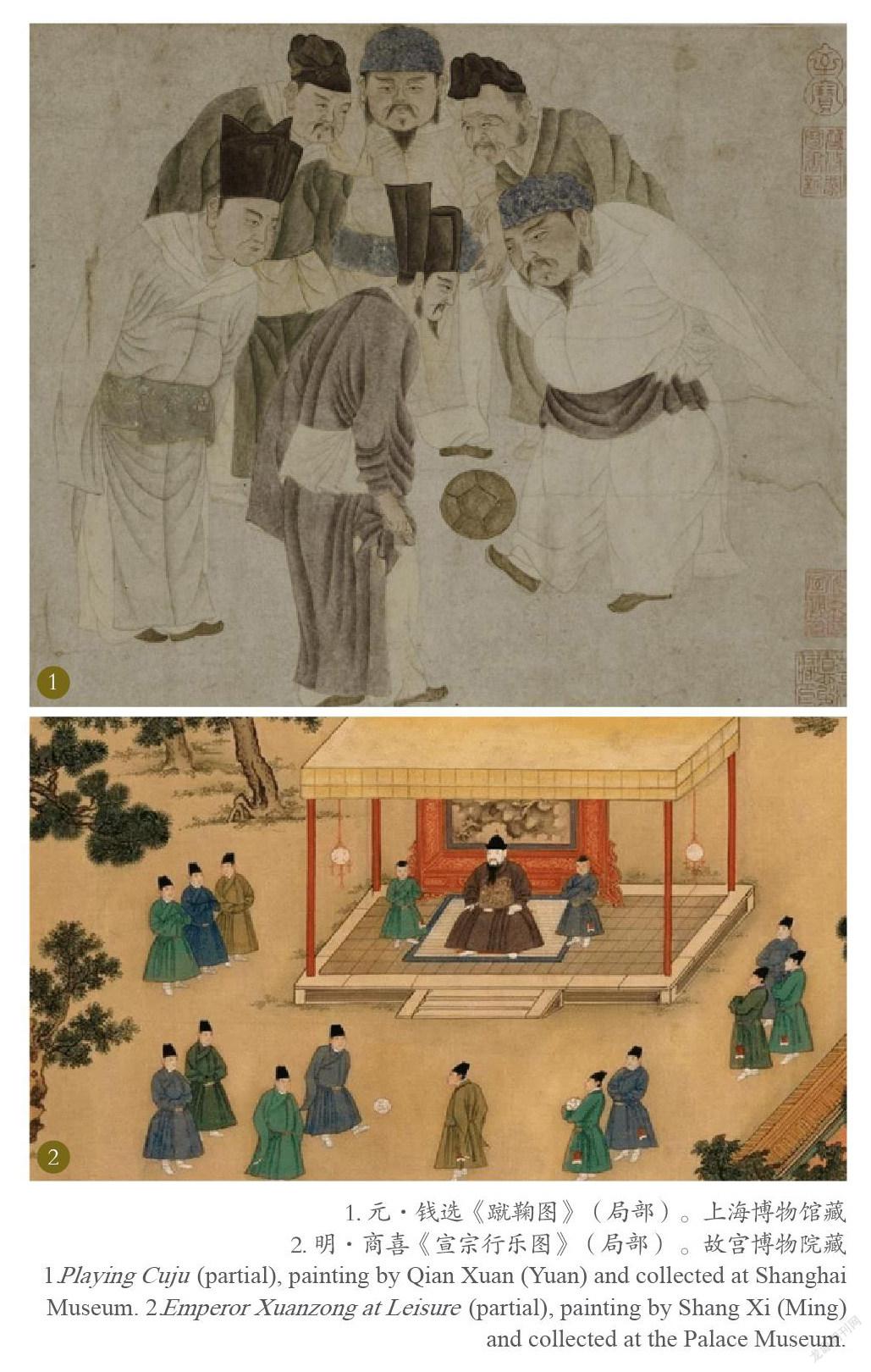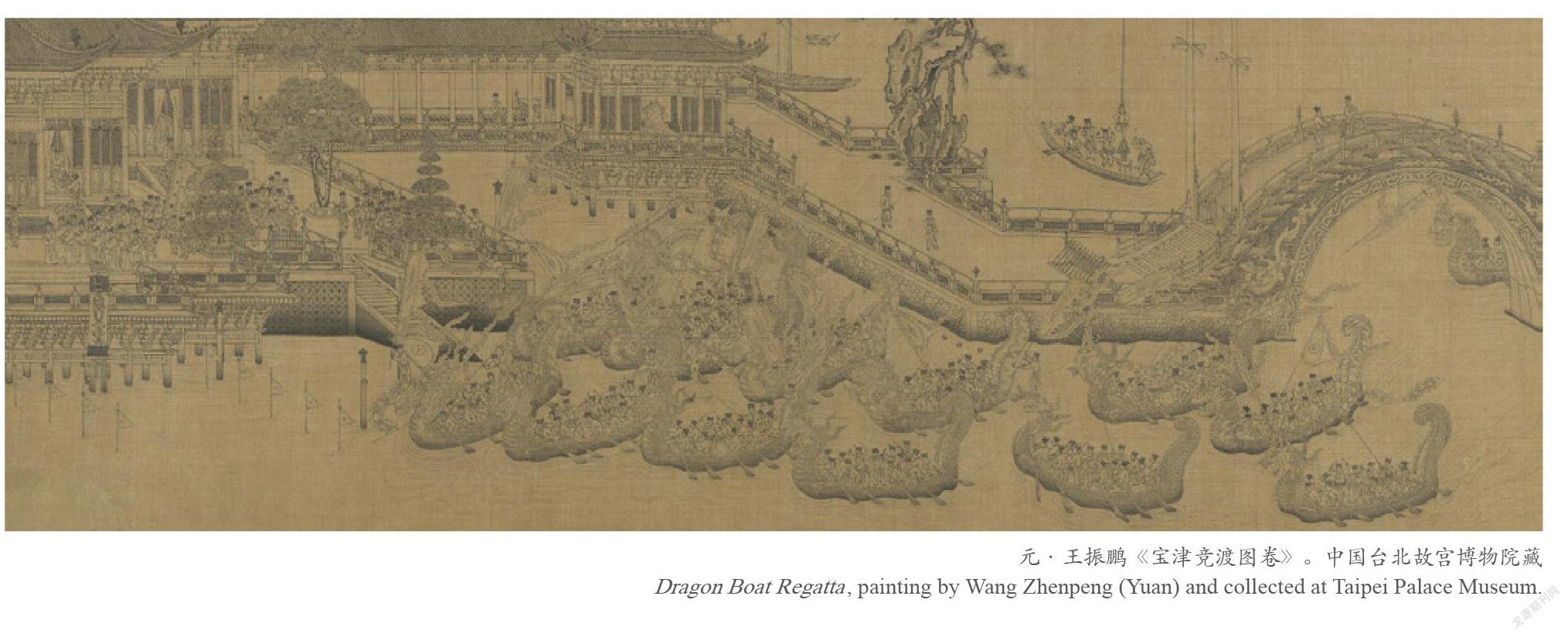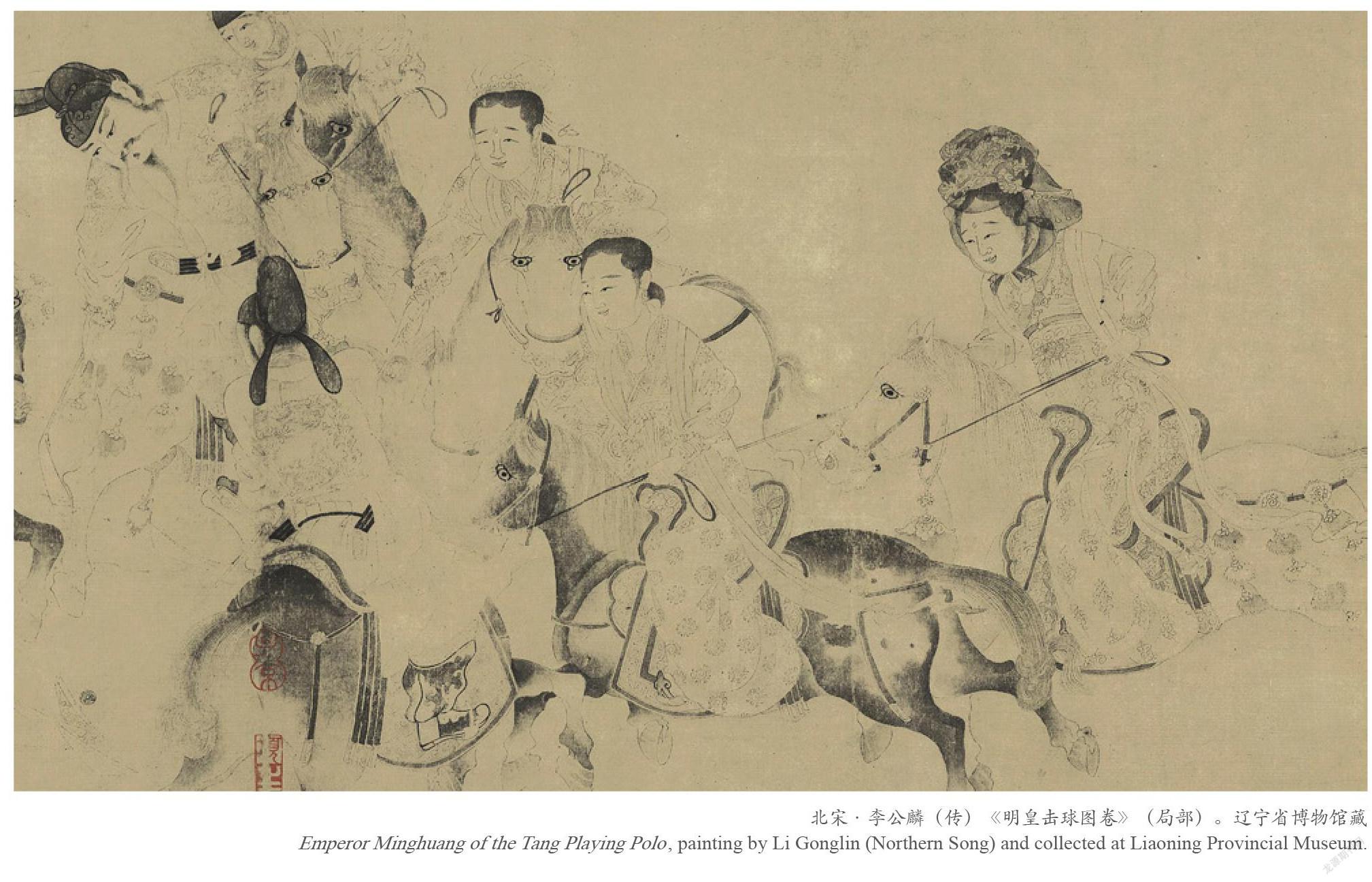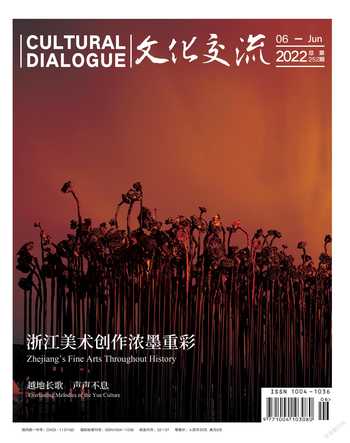宋人爱体育
蒋庭依



最近,刘畊宏的《本草纲目》毽子舞突然成为微博热搜,许多人都加入到跳操的行列里来,为生活增添不少乐趣。其实,人们对体育运动的热爱是亘古不变的,时光若退回到千年以前,在富庶繁华、文明得到高度发展的南北宋时期,也可以体验各种有趣而精彩的体育项目和体育活动,那时候人们对于体育运动的热衷与创造,一点都不逊色于现代人。
蹴鞠:古代足球比赛
“蹴鞠场边万人看,秋千旗下一春忙。”陆游的这首诗道出了宋代最重要的体育运动之一“蹴鞠”,它又名“蹋鞠”“蹴球”“蹴圆”“筑球”“踢圆”等。《史记》中有道:“临淄甚富而实,其民无不吹竽鼓瑟、弹琴击筑、斗鸡走狗、六博蹋鞠者。”这是中国古籍中最早的关于古代蹴鞠运动较为具体可信的记载。可见,在战国时期,蹴鞠就受到了人们的欢迎。
蹴鞠有“设球门”和“不设球门”之分。据《东京梦华录》记载,宋代进行单球门蹴鞠比赛时,场地上设一高三丈许的“球门”(又称风流眼),参赛者分为两队人马,分别着“红锦袄”和“青锦衣”这两种不同颜色的队服,使用“击”“踢”等方式使球进入风流眼。获胜方,“拜舞谢恩,以赐锦共披而拜也”;而输掉的一方,则只能“球头吃鞭,仍加抹抢”。
不设球门的蹴鞠形式,从原有的竞技性蹴鞠的基础上发展而来。它通常由一人独踢或两人、多人对踢,激烈程度减轻,技巧性增强,女性也特别适合参与。百姓们只需要寻找到都城中的一块林荫地,便能开展比赛。于是,男子们尽情地在赛场挥洒汗水,以博得倾心女子一笑,女子们也不甘示弱,组成“宋代娘子足球队”。
宋代蹴鞠不仅形成了较为完善的规则技术,与其有关的产业发展也日臻成熟。各种专门制作鞠的手工业作坊诞生,鞠的工艺水平从原来8片皮缝制升级为由10片或12片牛皮缝制的充气鞠。此外,宋代还形成了专门的蹴鞠组织——齐云社,又称“圆社”。它是由民间蹴鞠爱好者自发组织而成的社团,有词赞云:“若论风流,无过圆社。”齐云社每年会组织一次全国性的比赛——山岳正赛,以对蹴鞠者进行技术等级的评定。对于蹴鞠比赛的赛制规则、场地大小和设施,齐云社都有严格的规定,入会的会员也必须遵守严格的社规,如“齐云戒文”“十紧要”“十禁戒”“十不踢”“十不赛”等。
宋代是蹴鞠运动发展的鼎盛时期。宋代皇室甚至还将其作为隆重节日的表演内容。《宋史》记载,宋代皇帝在接见外交使臣时将蹴鞠作为表演项目,成为一种外交礼仪。《宋史 · 乐志》中提到的“每春秋圣节三大宴”,其中一项表演就是蹴鞠。宋太祖赵匡胤和宋太宗赵匡义都酷爱蹴鞠,元代画家钱选临摹的《宋太祖蹴鞠图》就形象地描绘了宋太祖、宋太宗和几位近臣蹴鞠的情景。
在宋代,不论是王侯将相,还是平民百姓,皆“以蹴鞠为乐”。
宋代相扑:女子角抵是特色
中国古代所谓的“相扑”运动起源于春秋时代的“角抵”“争交”,这是一种带有武术性质的民间游戏:人们戴着有角的面具互相比武、斗力。到了宋代,相扑融入更多技巧,演变为一种兼具竞技性和娱乐性的综合运动。据《东京梦华录》记载:“军头司每旬休按阅内等子、相扑手、剑捧手格斗。”宫廷每隔一段时间都要在全国范围内广搜强勇之人,训练他们成为专业的相扑手,以用于军事。除此以外,相扑还是宋代宫廷宴会娱乐的压轴节目。《梦粱录》卷三《宰亲王南班百官入内上寿赐宴》中也有记载 :“第九盏进御酒。左右军即内等子相扑。……宴罢,群臣入殿,谢恩退。”“内等子”是宋朝宫廷的职业相扑手,在宴会上,他们通过表演相扑来助兴。
除了专业相扑队外,民间相扑也有极为繁盛的发展,《梦粱录》又有云:“瓦市相扑者,乃路岐人聚集一等伴侣,以图摽手之资。”从中可以看出,没有正规编制的相扑者会在民间活动,他们的主要演出场所就是勾栏瓦肆,并且以此谋生。此外,市井街巷的相扑表演也热闹非凡,有“小儿相扑”“乔相扑”“女子厮扑”等各种新奇的形式。这些相扑艺人都有自己的艺名,比如男的叫周黑大、曹铁拳、铁板沓,女的叫赛关索、嚣三娘、黑四姐……
宋代的女子相扑可以说是一大特色。在古代,女子们被束缚于封建礼教的“三从四德”中,,鲜有机会抛头露面,更不必说在赛场上像男子那样搏斗。而宋代相扑场上的这些女子们,轻装上阵,在赛场上扭胯送腰、摩拳擦掌,为激烈的角逐更添一份独特风韵。宋代社会开放的风气可见一斑。
马球和捶丸:起源于帝王贵族运动
宋代王珪在《宫词》中描绘宋代女子表演马球风姿时写道:“内苑宫人学打球,青丝飞辔紫花骝。朝朝结束防宣唤,一样真珠络控头。”马球又称“击鞠”“打毬”,起源于东汉时期,兴盛于唐宋。曹植《名都篇》提到:“连骑击鞠壤,巧捷惟万端。”《明皇击球图》则展示了大唐盛世中唐玄宗与嫔妃、大臣打马球的恢宏场景。
一直沿袭到北宋,马球仍然是一种帝王贵族之间的时髦运动。据《金史 · 礼志》记载,“球状小如拳,以轻韧木枵其中而朱之”,宋代的马球大致相当于成年人的拳头大小,有木制和皮制的两种。从《宋史 · 礼志》的记载中可了解当时打马球的规则:打球分两队竞赛,以“承旨”守门。每队人数无定额,少则两人,多则数百人;两队所穿服装不同,便于识别;两队待球掷至球场中央开始比赛,单球门赛以球打入球网为胜,双球门赛,将球打入对方球门为胜。
《宋史 · 礼志》记载了宋太宗与诸王大臣们打马球的场面:“帝击球,教坊作乐奏鼓。球既度,呜钲、止鼓。帝回马,从臣奉觞上寿,贡物以贺。赐酒,即列拜,饮毕上马。帝再击之,始命诸王大臣驰马争击。旗下擂鼓。将及门,逐厢急鼓。球度,杀鼓三通。球门两旁置绣旗二十四,而设虚架于殿东西阶下。每朋得筹,即插一旗架上以识之。帝得筹,乐少止,从官呼万岁。群臣得筹则唱好,得筹者下马称谢。凡三筹毕,乃御殿召从臣饮。”
北宋时期,女性马球运动也有了较大发展。宋徽宗时组建了宫廷女子马球队,每到节日时会组织表演,让百姓观赏。后来也逐渐形成了宫廷女子马球队每年春天在金明池汇演的定例。明媚的春日,在位于汴京城新郑门外的金明池,女子马球比赛从百戏中脱颖而出。女子们头扎软巾,腰束玉带,足登马靴,在賽场上“控马攀鞍事打球,花袍束带竞风流”,她们香汗淋漓的背影成为一道亮丽的风景,男子们看了也只得甘拜下风。D94A8715-4AD3-479C-A711-AC227A050FCC
捶丸最開始也是一种“贵族运动”,它在皇室贵胄中流行,并逐渐在民间发展。宋太宗每年都会举行捶丸活动,在捶丸活动开始时,无论是大臣还是民间艺人都会上台表演捶丸技艺。“捶”即击打,“丸”即小球,到了宋代,捶丸的游戏规则由两队竞赛变成了依次击球的非对抗性比赛。
宋代体育专著《丸经》中曾这样描述这项运动:“天朗气清,惠风和畅,饭饱之余,心无所碍,取择良友三三五五,于园林清胜之处,依法捶击。” 宋人捶丸对场地的选择十分讲究,一般会选择有山有水有绿植的地方。因此这种运动被一些人戏称为“宋朝高尔夫”。
此项竞赛人数不宜过多,3至10人最佳,球必须用“击”,“挑”“刮”“推”“拨”等皆视为违规。最重要的是遵守捶丸比赛的宗旨:“捶丸之式,先习家风,后学体面。折旋中矩,周旋中规。失利不嗔,得隽不逞若喜怒见面,利口伤人,君子不与也。”可以简单概括为“比赛第二,友谊第一”。据传宋徽宗酷爱捶丸,《丸经集叙》中记载他的球棒“碾玉缀定,饰金缘边”,令旁人羡煞。
除了这些体育运动之外,宋代许多体育活动也得到高度发展。
踏索与上竿:高难度高风险体育项目
踏索,顾名思义是一种高空走绳运动,又名走索、上索,其最大的特点就是惊险、刺激。表演之人必须掌握平衡之术,将百来斤重的身体稳稳地控制在悬空的绳索上来回移动,偶尔一个小小的摇晃,都能令底下的观众倒吸一口凉气,正所谓“闪然欲落却收得,万人肉上寒毛生”。
踏索表演者们技艺高超,由此一种比踏索更高难度的“跳索”应运而生,要求表演者在绳索上旋转、跳跃,甚至翻个跟头。他们健步如飞,借助绷紧后的绳子的弹力表演各类花式动作。即使两个人相对而走至“狭路相逢”处,也能“肩相切而不倾”,从容应对。这样的场景被记录在《文献通考 · 乐二十》之中:“汉世以大丝绳系两柱头闲,相去数丈,两倡对舞,行于绳上,对面道逢,肩相切而不倾。”
挼曲子:媲美现代踢踏舞
早在宋代,其实就有了可与现代踢踏舞相媲美的“挼曲子”。在勾栏瓦肆里,经常可以看到众多女子正翩翩起舞,她们精神饱满,步伐整齐,动作不徐不疾,恰到好处。
《东京梦华录》的《宰执亲王宗室百官入内上寿》写道 :“每遇舞者入场,则排立者叉手,举左右肩,动足应拍,一齐群舞,谓之‘挼曲子。”简而言之,挼曲子是一种节奏感极强的伴舞,在正式舞蹈表演开始之前,舞者们穿上亮丽的裙衫华丽登场,并作舞一段,其目的是为了调动现场的气氛,类似于现代人所说的“暖场”。在一片欢呼雀跃之中,年轻貌美的姑娘们两手叉腰,耸动着左右肩膀,双脚跟随着音乐的节拍,快速而有节奏地在地上画圈、摩擦、打击。她们的身体在空中划出好看的弧度,翩然的衣袖随之飞舞。观众们一会儿被她们曼妙的身姿所吸引,一会儿又惊叹于复杂而娴熟的舞步技巧,目不暇接。
龙舟竞渡和水秋千:水上运动人气高
宋代的龙舟竞渡,也称“争标”,一般在清明节前后举行。《东京梦华录》记载,参加竞渡的龙船五花八门,有小龙船、虎头船、飞鱼船、鳅鱼船。众小船围绕着金碧辉煌的大龙船排列阵式,“旋罗”“海眼”“交头”阵相交替,如众星拱月,最后各船列成一排,向终点标杆急驰竞速,争夺到锦标者为胜。
在宋代,还有一种特色的水上运动——水秋千,它是中国古代水上体育活动之一,始见于宋代,在百戏之中独具风姿。朱翌曾写诗《端午观竞渡曲江》回忆宋代表演水秋千的盛景:“却忆金明三月天,春风引出大龙船。二十余年成一梦,梦中犹记水秋千。”
水秋千是古代的一种跳水运动形式,因它是以秋千作为跳水板,所以难度比起现代的跳水更高。在表演之前,需在水面置两艘大船,中间搭建秋千架。在喧天的锣鼓声中,表演者按次序登上秋千,他们奋力地荡动秋千,以使秋千荡至最高处——与秋千架的横梁齐平,此时猛然脱手,借秋千回荡之力跃入空中,在空中翻着跟斗,然后如燕子般轻灵地落入水中。
这种高难度的水秋千运动每年只有一次,和龙舟竞赛在同一天进行。每逢这天,汴京城内便人声鼎沸,连皇宫中的宫女都争相登上楼阁,撩开珠帘,屏息凝声地等待着水秋千表演者腾空而起,上演惊险又刺激的一幕,以饱眼福。
Sports in the Song Dynasty
By Jiang Tingyi
The recent smash hits by Chinese singer Liu Genghong — fitness videos posted by him on Douyin, the Chinese version of TikTik — have reignited peoples interest in workout and exercise. In fact, peoples love of sports has never changed throughout history. For example, if we could travel back to a thousand years ago in the Song dynasty (960-1279), we would enjoy all kinds of interesting and exciting sports and physical activities. At that time, peoples enthusiasm for sports was at least equal, if not more so, to ours today.
Cuju: Mother of Modern Football
“Ten thousand spectators gather around the cuju pitch, busy through the spring under swings and flags.” Thus written Lu You (1125-1210), one of the foremost poets in the Song dynasty, on one of the most important sports of the period. Cuju, which literally means “to kick” (cu) and “a type of leather ball” (ju), is also alternatively known as taju, cuqiu, tiyuan, among other names. It is believed to be the earliest known recorded game of football. Shiji, or Records of the Grand Historian, published during the Han dynasty (202 BC-220 AD), describes the game as being quite popular in one of the states during the Warring States (475-221BC) era.D94A8715-4AD3-479C-A711-AC227A050FCC
The game was generally played in two ways, with goalposts and without goalposts. According to Dongjing Menghua Lu, or The Eastern Capital: A Dream of Splendor, a book on the history and customs of the Song capital, the cuju games were generally played between two sides, one dressed in red and one in black, with goalposts as high as 10 meters. The winning side would be awarded prizes such as fine silks while the losing side was faced with punishment.
While the game had been played since the Warring States period, it was during the Song dynasty that cuju became a more formalized sport, with a set of mature rules and even spawning a whole industry around it. For example, the craft of making ju, or the leather ball, was more developed and stringent. Instead of eight pieces, 10 or 12 pieces of cowhide were sewn together to produce a leather ball before being filled with air. Many workshops specialized in the production were born, which sold various brands of the leather balls. In addition, an organization called Qiyun She (or Qiyun Association) similar to todays football associations was also formed, and people who played cuju at the time were enthusiastically joining the association, as a national tournament was organized by it every year. Indeed, members of the association had to strictly follow its rules and regulations, which asked them to show respect and integrity and not to engage in such vices as gambling or fighting.
Cuju was so popular in the Song dynasty that it was usually dubbed its “national game”. According to the History of Song, the royal court even made the game part of the performances for visiting foreign delegations. Emperor Taizu Playing Cuju, a painting by Qian Xuan (1239-1299), shows the scene in which Emperor Taizu of Song (927-976), Emperor Taizong of Song (939-997) enjoying the game with courtiers.
Xiangpu in the Song: A Game for Ladies to Play too
Xiangpu in ancient China was a wrestling sport that was first born in the Spring and Autumn period (770-476 BC), which had been known as juedi or zhengjiao. It is a folk game which had incorporated elements of martial arts in it: people wearing horned masks competed with each other. In the Song dynasty, xiangpu evolved into a comprehensive sport with more emphasis on skills, making it both competitive and entertaining. At regular intervals, the imperial court would scour the country for talents and train them to become professional xiangpu wrestlers in the military. Moreover, xiangpu was also the grand finale for banquet entertainment in the Song court.D94A8715-4AD3-479C-A711-AC227A050FCC
Apart from professional xiangpu teams, folk xiangpu was equally popular. In fact, many xiangpu players performed wrestling as a form of entertainment to earn a living.
A big feature of the sport at the time was the wide participation of women. While women playing in sports, especially those that required bodily contact and light clothes such as xiangpu, had not been unseen before the Song dynasty, it became much more common during the period. In a way, it showed the elevated status of women as well as the enlightened attitude of the Song society towards them.
Maqiu and Chuiwan: Sports for the Royals
Maqiu, or polo, also known as jiju and daqiu, first emerged in the Eastern Han (25-220) period and gained much popularity in the Tang and Song eras. Maqiu remained largely a sport among the royals until the Song dynasty, when cleared rules were devised. Two teams dressed differently would compete in a maqiu match, with an unspecified number of players on each team, ranging from two to a few hundred. They would kickstart a game when the maqiu ball was dropped in the middle of the court. In a match only one goal, the team that first put the ball in the net won while in a double-goal match, the team first putting the ball in the other team's goal won. Like xiangpu, women competed in maqiu games as well in the Song dynasty.
Similar to maqiu, chuiwan was a royal sport in the beginning, too, which gradually spread to the general population over time. The chuiwan games are remarkably similar to modern golf. About three to 10 players used a number of clubs (up to 10 in chuiwan, 14 in golf), with holes dug on different types terrains, marked by colored flags. These players were required to abide by strict etiquette and rules on honesty, with penalties for cheating. Chuiwan balls were of different sizes and made of wood.
In addition to the above games, many sports in the Song Dynasty were highly developed as well.
For example, there was tiaosuo, which was walking on a tightrope at a certain height. Risky to the performers yet exciting to the spectators, tiaosuo performances included such moves as jumping, gyrating and even somersaulting. There was the popular nuo quiz, which was a type of dance quite like todays tap dance. Then there were also the dragon boat racing, which was usually held around the Qingming Festival or the Tomb-Sweeping Day, and the unique Song sport shui qiuqian. The latter was an activity in which two boats would be stationed on a lake or a body of water with a set of qiuqian (swing wood boards) erected in between. Players would then swing on the boards, usually as high as the beam of the qiuqian, and jump into the river, not unlike todays diving.D94A8715-4AD3-479C-A711-AC227A050FCC

